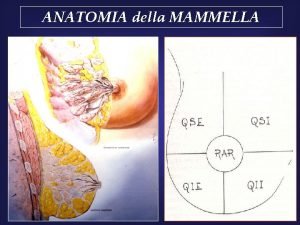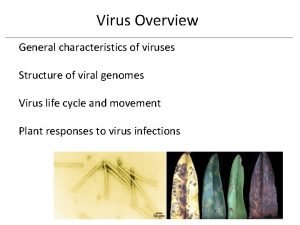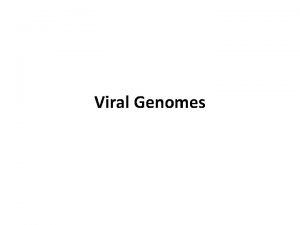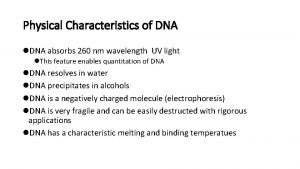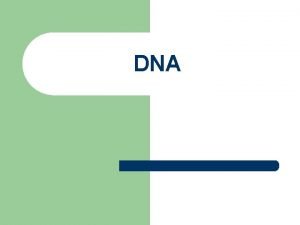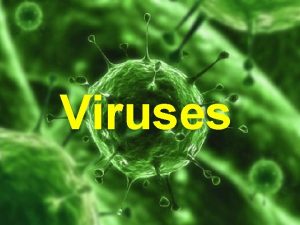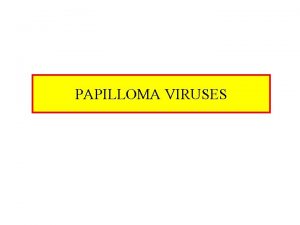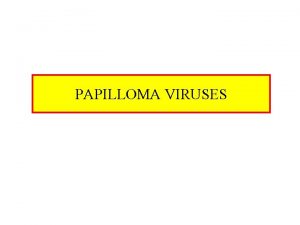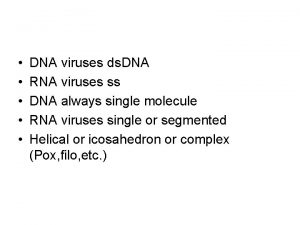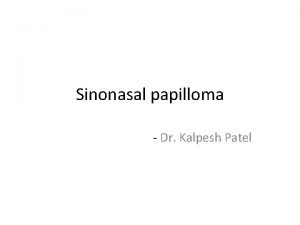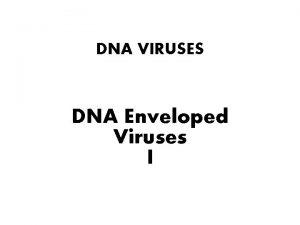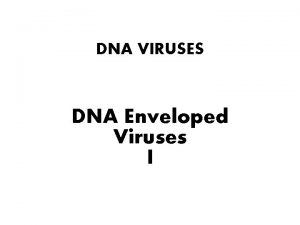PAPILLOMA VIRUSES Papilloma Viruses Characteristics ds DNA viruses














- Slides: 14

PAPILLOMA VIRUSES

Papilloma Viruses • – – Characteristics ds. DNA viruses (circular) Genone 8 kbp Genome associated with cellular histones Naked capsid Widespread in humans and other animals They cause ‘warts’ Some strains 16, 18 and 31 associated with high risk of cervical cancer – Over 100 types of HVP found so far


Papilloma Viruses • – – – • • Different types infect different anatomical sites HPV-1 target feet HPV-2, 4, 7 hands Virus targets mucosa (oral, nasal, genital) OR skin Transmission of genital tract HPV thru sexual contact Transmission of skin HPV thru touching, or contaminated surface • HPV that infect genital tract mucosal can cause – cervical warts referred to as ‘condylomas’ (benign rarely progress to cancer) – Strains 16, 18 and 31 associated with high risk of cervical cancer such as Squamous Cell Carcinoma • Referred to as Oncogenic HPVs • Genital tract infections are transient in many cases cause no symptoms • Lack of symptoms allows for easier spreading

HPV 16 • HPV 16 is of interest due to oncogenic properties • • 6 Early genes (E 1, E 2, E 4, E 5, E 6 and E 7) 2 Late genes (L 1 and L 2) Genome has multiple ORFs Variable Splicing of m. RNA transcripts yields variety of m. RNAs with multiple ORFs – Virus targets mucosa (oral, nasal, genital) OR skin • Transmission of genital tract HPV thru sexual contact • Transmission of skin HPV thru touching, or contaminated surface

Infectious Cycle • • Infection requires entry to NON-DIFFERENTIATED basal cells Virus binds to heparin and 6 -integrin Virions are taken in by endocytosis Genome ends up inside nucleus – Stays as circular DNA – Does not incorporate itself into host genome • Replication of genome occurs generating 50 -100 copies – Every cell division genome is duplicated and split equally between parent and daughter cell – This type of division is referred to as ‘plasmid replication’ • When Basal Cells become Keratinocytes burst of viral replication occurs – This burst is called vegetative replication – During this same period L 1 and L 2 genes are expressed producing capsids – Release of assembled virions occurs during cell death

HPV 16, 31 Genome Structure Ø In undifferentiated basal cells Pearly transcribes all six E genes Ø Transcript terminates at Poly(A)early Ø Poly(A)early immediately after E genes resulting in no expression of Late genes Øm. RNAs generated have multiple ORFs, unclear how ribosomes translate them

HPV 16, 31 Genome Structure Ø Late promoter (Plate) active in Keratinocytes Ø When E 1 and E 2 levels increase a shift occurs towards vegetative DNA replication Ø Transcripts from Plate terminate to Poly(A)late Giving rise to L 1 and L 2 ØAlternative splicing is responsible for the shift in E 1 and E 2 and ultimately increase in L 1 and L 2 ØL 1 and L 2 encode for capsid proteins which leads to an increase in virion production ØSplicing of Plate-Poly(A)late transcript results in removal of E genes and expression of only L 1 and L 2 genes

Functions of HPV Proteins Ø E 1 is a DNA helicase, binds replication origin and initiates DNA replication. By unwinding genome cellular DNA polymerases can replicate viral genome Ø E 2 enhances binding of E 1 onto replication origin Ø E 6 enhances degradation of p 53 protein which is a major cell cycle control protein ØE 7 binds Rb protein increasing cell cycling ØL 1 major capsid protein ØSplicing of Plate-Poly(A)late transcript results in removal of E genes and expression of only L 1 and L 2 genes ØSome cellular transcription factors known to bind regulatory sequences of PV genome are: NF-1, SP 1 and AP 1

Viral Replication Surges in Keratinocytes Ø Replication surge is unusual given the fact that keratinocytes are terminally differentiated and do not carry any significant DNA replication Ø E 7 is responsible for this peculiarity, binds Rb resulting in release of E 2 F transcription factor ØE 2 F then participates in expression of a variety of genes involved in cell cycle ØE 7 binds Rb protein increasing cell cycling, essentially convincing keratinocytes to divide ØRb is a major tumor suppressor protein. Many retinoblastoma cancers are due to mutated Rb

E 6 Eliminates p 53 Ø p 53 normally induces apoptosis of cells that should not be dividing such as Keratinocytes Ø p 53 neutralization is achieved by ubiquitination which leads to proteasome degradation Ø similar to Rb, p 53 mutations are observed in a variety of cancers

p 53 Function Ø p 53 normally is in low levels in the cytosol and inactive Ø In stress conditions: • increase in phosphorylation occurs making it more stable • Increase in p 53 expression also occurs Ø p 53 activation can stop cell cycling at G 1 for repair ØOR cause apoptosis ØIn many cancers p 53 is mutated, in HPV is NORMAL!! ØNo reason to mutate, simply eliminate by ubiquitination

Cervical Cancer Cell Lines Induced by HPV Ø Surprisingly do not produce HPV virions! Ø In these cell lines genome is inserted into host genome ØNormal HPV infected cells do not incorporate HPV genome into their own genome ØE 6 and E 7 are the only genes being expressed in HPV related cancers ØNo surprise E 6 and E 7 target p 53 and Rb respectively ØViral integration into host cellular genome has no advantage Ø Expression of E 7 allows neutralization of Rb, release of E 2 F and expression of cell cycling genes ØNormally p 53 would eliminate them but p 53 itself is eliminated through E 6

Cervical Cancer Diagnosis and Prevention Ø Pap test has been the main diagnostic tool for cervical cancer for decades. Ø The discoverer is George Papanicolaou ØSignificantly reduces mortality rates of cervical cancer ØCervical warts are pre-malignant tumors and often removed surgically or freeze killed with liquid nitrogen ØHVP vaccines are now available that raise immunity against L 1 protein of HPV strains 16, 18 (Guardasil includes L 1 from stains 6, 11, 16 and 18) ØL 2 is considered in vaccination trials, could provide immunity against wider range of HPV types ØVaccination is recommended at young age before encounter with virus i. e ages 11 -12
 Youtube . com / watch v = roxnvcaezjs
Youtube . com / watch v = roxnvcaezjs Unlike lytic viruses, lysogenic viruses do not
Unlike lytic viruses, lysogenic viruses do not Galattografia papilloma
Galattografia papilloma Inverted papilloma
Inverted papilloma Pineal tumor
Pineal tumor General characteristics of viruses
General characteristics of viruses General characteristics of viruses
General characteristics of viruses Replication fork
Replication fork Bioflix activity dna replication dna replication diagram
Bioflix activity dna replication dna replication diagram Coding dna and non coding dna
Coding dna and non coding dna Replication process
Replication process Dna rna protein synthesis homework #2 dna replication
Dna rna protein synthesis homework #2 dna replication Characteristic of dna
Characteristic of dna Characteristics of dna
Characteristics of dna Why are viruses considered nonliving?
Why are viruses considered nonliving?


